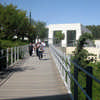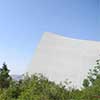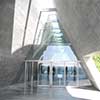Yad Va’Shem Holocaust Museum, Jerusalem Building, Israeli Architecture
Yad Va’Shem Holocaust Museum, Israel
Jerusalem History Building – design by Safdie Architects
13 + 8 May 2013
Jerusalem Holocaust Museum
Design: Safdie Architects
Location: HaZikaron, Jerusalem, Israel
Yad Va’Shem
Project Review by e-architect Editor Adrian Welch
Finally we visited the Yad Va’Shem Holocaust Museum, again in Jerusalem, but set some way out of the city centre. The building was designed by Moshe Safdie led by Irit Kochavi who runs IK Architects in Israel. Again like the Israel Museum this is a new intervention significantly extending a 20th Century building set on a small hill.
Walking down the ramp from the entry building to the The Holocaust History Museum:


photographs © Adrian Welch
Many architects will be familiar with the key architectural element of this building, the phenomenal insitu concrete form that slices through the hillside. A strong architectural promenade starts with the winding route down to a simple white trabeated fram that straddles the vehicular circulation immediately prior to the turning circle. The a gentle slope (4 degrees) slows you as you walk up to the entrance pavilion, a Suka-style block that takes non-core museum functions such as toilets away from the actual museum.
You then walk above nature across a long bridge going down with the valley on your left. You enter the 180m long building and look right to see the amazing vista, but then head left where the end wall shows a looping video. You double back after this and start the long and winding route through the building. The slope falls slowly towards the midpoint of the space, which coincides with some of the lowest moments in the holocaust history.
The Hall of Names:




photographs © Adrian Welch
The concrete walls are canted in on both sides and carry a triangular-sectined glass rooflight along the entire length of the building. But one cannot walk from end to end, the way is barred by cuts trhough the floor, forcing visitors in a route into exhibition spaces either side of the main space. there are also two routes on the hill that cut through the space, one for pedestrians and one for vehicles. These cuts provide views of sky, trees and people above, helping to provide a small antidote to the sombre mood below as one follows the horrors of the holocaust.
Towards the end of the main space as you walk gently uphill towards the light is a circular space on the right that contains a record of all those killed in this apalling episode for mankind. This space is in some ways architecturally uplifting in terms of space and light. Finally you leave the interior through glass doors and the breeze and sunlight hits you as you are drawn to the edge of the deck, looking out over the trees across a valley. The concrete walls (made using a single 10m long x 2.5m high form that was moved along the space on multiple levels) open out here and this is both an architectural and an engineering tour-de-force as the walls subtley curve out in plan but also curve up in section, cantilevering out over the valley.
Pleasant courtyard that follows the The Holocaust History Museum ; circulation up to the Hall of Remembrance:



photographs © Adrian Welch
A whole series of major buildings and experiences follow within the ‘campus’ on the hill site, including the monolithic square-plan Hall of Remembrance – containing the eternal flame – but these are buildings before Moshe Safdie’s work.
Hall of Remembrance by architect Arieh Elhanani, Eternal Flame by Kosso Eloul:


photographs © Adrian Welch
Triangular top glazed extrusion along the Holocaust History Museum, acting as a rooflight:



photographs © Adrian Welch
The Pillar of Heroism, 1967-70, by Buki Schwartz

photograph © Adrian Welch
Children’s Memorial by Moshe Safdie; The Holocaust History Museum entry building by Moshe Safdie:


photographs © Adrian Welch
The Children’s Memorial designed by architect Moshe Safdie – hollowed out from an underground cavern – is a tribute to the approximately 1.5 million Jewish children who were murdered during the Holocaust. Memorial candles, a customary Jewish tradition to remember the dead, are reflected infinitely in a dark space, creating the impression of millions of stars shining in the firmament. The names of murdered children, their ages and countries of origin can be heard in the background. The children’s names are taken from Pages of Testimony in the Hall of Names, Yad Vashem.
The Holocaust History Museum Synagogue:

photo © Adrian Welch
New Synagogue at Yad Vashem Showcases Judaica from Destroyed Synagogues in Europe. This building designed by architect Moshe Safdie and the interior design firm Tamuz is a place where visitors can say kaddish for beloved departed ones, where individuals can gather in silent prayer or join a traditional minyan in the communal atmosphere of a synagogue, and as a monument to the destroyed synagogues of Europe.
Yad Va’Shem Holocaust Museum
Project Description
The rebuilding of the Yad Va’Shem Holocaust Museum includes a new visitors’ center (Mevoah), a new history museum replacing the existing museum constructed in 1953, a Hall of Names, a synagogue, galleries for Holocaust art, an exhibitions pavilion and a learning and visual center. In addition, new underground parking and facilities for tour buses are located adjacent to a new entrance piazza. The overall program quadruples the permanent exhibition space.
The mevoah is an arcaded concrete pavilion roofed by skylights and trellises, which cast ever-changing shadow patterns. It is reminiscent of a Succah. The lower level accommodates a restaurant and other public services.
The historic museum consists of a mostly underground prismatic structure 16.5 meters high and 183 meters long (54 x 600 feet) that cuts through the Yad Va’Shem hillside, penetrating from the south and protruding to the north. A network of skylit underground galleries lines both sides of the prism.
The Hall of Names, located toward the end of the historic museum, is a conical structure extending upward 9 meters (30 feet) and housing the personal records of all known Holocaust victims. A reciprocal cone, penetrating deep into the Jerusalem bedrock below, echoes the upper chamber and commemorates those whose names will never be known.
The 20-hectare (50-acre) site also includes the Children’s Holocaust Memorial and the Transport Memorial, designed by Moshe Safdie and completed in 1987 and 1995, respectively, as well as the Hall of Remembrance, administrative offices, an education and archival center and the Valley of the Communities.
Building adjacent to The Holocaust History Museum (located to the east) – International School for Holocaust Studies:

photo © Adrian Welch
Yad Va’Shem Holocaust Museum information from Safdie Architects
Location: HaZikaron, Jerusalem, Israel, Middle East
Israel Architecture Designs
Contemporary Israel Architectural Selection
Contemporary Jerusalem Museum Buildings Selection
Israel Museum, Jerusalem
Design: various architects
Israel Museum
Museum of Tolerance Jerusalem
Design: Chyutin Architects
Museum of Tolerance Jerusalem
Contemporary Israel Museum Buildings Selection
Tel Aviv Museum of Art Extension
Design: Preston Scott Cohen
Tel Aviv Museum of Art
Museum + Archive – Jabotinsky Center, Ramat-Gan
Design: Chyutin Architects
Museum + Archive – Jabotinsky Center
Design Museum Holon, Tel Aviv – review + photos by e-architect editor Adrian Welch
Design: Ron Arad
Design Museum Holon
Umm el-Fahem Museum for Contemporary Art Israel
Design: SO architecture
Um el Fahem Museum
Comments / photos for the Yad Va’Shem Holocaust Museum – Jerusalem Architecture page welcome




























